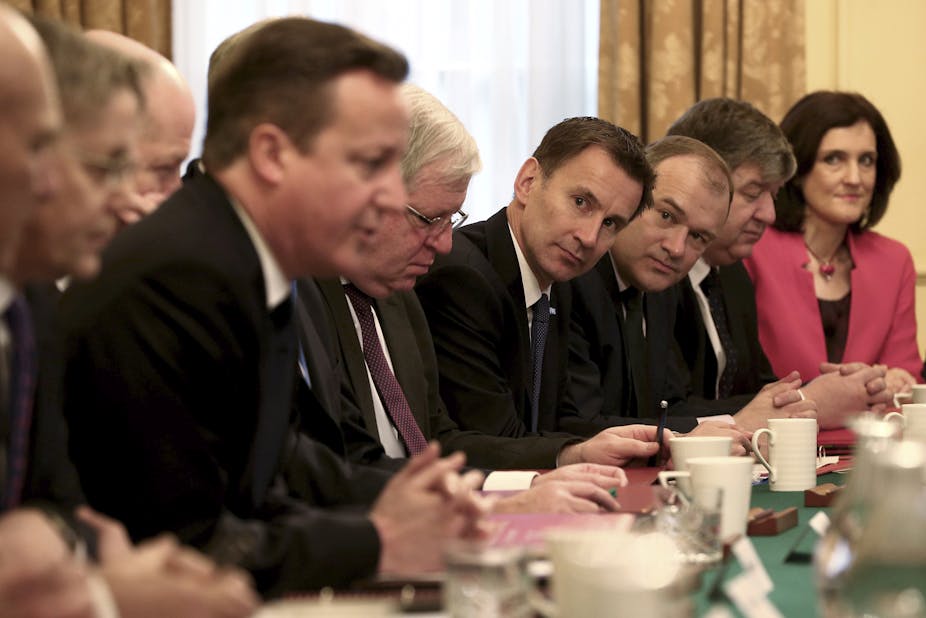In outlining his 25-year vision for the NHS, the secretary of state for health, Jeremy Hunt, has been at pains to highlight the important part played by Conservatives in the founding of the service and in its subsequent guardianship. The implication was clear, as prime minister David Cameron, has said for nearly a decade: “The NHS is, and always has been, safe in our hands.”
It’s easy to understand why Hunt might try to make this claim. Four years before the NHS officially came into being, the wartime Conservative-led coalition published a 1944 white paper that certainly set out the need for a “free” and “comprehensive” healthcare service. It was presented as a natural evolution from past provision. But how different was it from the later NHS blueprint?
Under the 1944 white paper, voluntary hospitals (financed by local fundraising and workers’ contributions) would remain independent, not be taken over by the state. They would instead contract services from newly established local joint authorities, comprising amalgams of city and county councils. These authorities would also run the existing municipal hospitals. The white paper placed local authorities at the centre of hospital governance.
It was planned, also, to establish local authority health centres, where GPs would provide primary care for the community. In short, the Conservative emphasis was decidedly more pluralistic than the state-centric nationalised service we got in 1948, similar in some way to the “internal market” in health set up after 1989.
Reassurance and generating fear
Approaching the May general election, the NHS emerged above immigration and the economy as the most important voter issue. Popular concern had been rising steadily since the election of a Conservative-led coalition government, with Labour consistently polling 15-20% ahead on health issues. Distrust meant 85% of the public thought health spending should be protected (ahead of schools, 49%, and care for the elderly, 45%). A third of people thought the NHS was getting worse.
So if the political game for the Conservatives is about reassurance, for Labour it’s about generating a fear of creeping privatisation and underfunding. The past, in this rendition, is the anathema to which we must not return. Indeed, beyond an increasingly limited group of older people, most of us cannot imagine a positive pre-NHS past.
Speaking at the 2014 annual Labour conference one elderly supporter remembered: “Back then hospitals, doctors and medicine were for the privileged few because they were run for profit rather than as a vital state service.” It was “moving” and “heartbreaking”, shadow health secretary Andy Burnham said, “something everyone should hear.”
So how bad was healthcare before 1948? Despite what we might imagine, the public thought well of it. Gallup, polling in July 1944, found 85% of former hospital patients were satisfied with their treatment: roughly the same numbers as after 1948. The most frequent “grumbles” before and after focused on admission delays, outpatients waiting times, poor food, and so on. The national insurance-funded GP service – covering working people but not their dependents – was less popular.
All in all, three quarters of patients were content. Perhaps most surprising to our modern ears is that there was no great hunger for radical reform. Mass-Observation, surveying in 1943, found that “roughly half the population was opposed to any major change on the health front, a quarter disinterested and a quarter in favour of state intervention.”
Middle classes missed out
Contrary to what we might think, access to hospital care was restricted not to the rich but to ordinary working people. Voluntary hospitals were charitable foundations; not there to make profits. The standard method of payment was via a mutual contributory fund. These charged two or three pence a week to cover the contributor and family.

Local authority hospital provision was also expanding and improving. The largest single group excluded from hospitals was the middle classes: barred because they earned too much. Only recently had pay-bed wings been established to cater for this group. Otherwise the middle classes relied on private nursing homes, which were expensive. It was this group arguably that was the chief beneficiary of the founding of the NHS.
Many key accounts explain the formation of the NHS largely in terms of a growing reforming consensus driven by forces outside of party politics. Such an explanation, of course, suits neither political party, least of all Labour. But the past is politically malleable. Doctors, when opposing the 2012 Lansley health and social care reforms, were quick to raise the spectre of the Americanisation of health, and of a return to the bad old days of the 1930s.
You wonder if Hunt has learnt a lesson from this, but also how he will fare in his battle with the medical profession? Both Henry Willink, who introduced the 1944 white paper, and Nye Bevan, who introduced the NHS, ended up giving considerable ground to the medical lobby. Many in the Conservative Party strongly supported the British Medical Association’s objections on such key issues as the continuing independence of voluntary hospitals, resisting local authority control, a salaried medical service, and the retention of private practice.
Willink’s proposals were slowly whittled away. Bevan, too, was to face mighty battles with the BMA after 1945. Yet his is the service that we would most readily recognise today.

